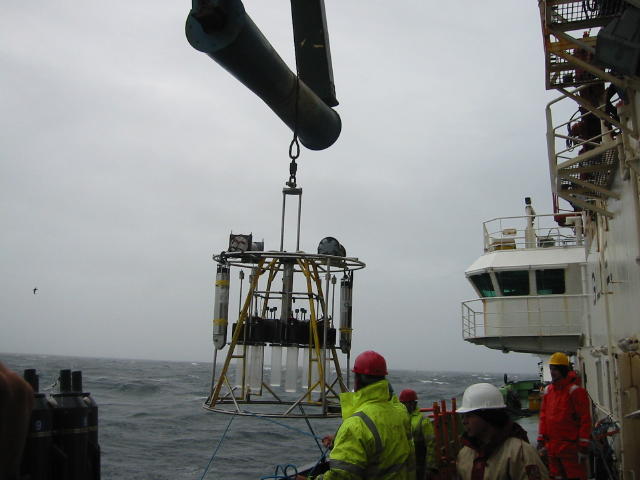After a week of steaming to the southeast from South Africa
we have finally reached our first benthic station –
M10! This station
is 2936m deep, a bit shallower than the two main stations
M5 and M6
around the Crozet Islands. This first station gives many
of the scientists a chance to test out their equipment,
as well as getting some samples for meiofauna (tiny animals)
and chemical analysis.
The megacorer was next to go in the water. Many of the scientists
on board require sediment samples so this was an important
event – it felt like nearly everyone on board had
their fingers crossed that it would work! After a 4 hour
deployment it came up full of cores – only one core
tube didn’t fire. Not a bad start to sediment coring.

Megacorer is deployed
SPRATS was then deployed for testing – this is a new
piece of equipment which we hope will bring a sample of
deep water to the surface at the ambient pressure. At 3000
meters water depth, the pressure is equivalent to 300 atmospheres
and we want to make sure that we can recover water at that
pressure. The test at M10 highlighted a few problems, but
David and John both seem confident that these can be fixed
before the next deployment. More on this later.
The rest of the sampling at M10 was for the scientists
studying the water column, from the surface to the deep.
A CTD profiled the salinity and temperature at the site,
as well as taking water samples at discrete depths for nutrient
and chlorophyll analysis, which tells us something about
the state of the phytoplankton bloom.
SAPS (stand alone pump system) were deployed to collect
suspended particles, but did not work – a disappointing
end to an otherwise good day.
We are now steaming towards M5 – we hope to arrive
in 24 hours time. This will give us a chance to do some
last minute adjustments and modifications to our equipment
in preparation for our arrival at M5.